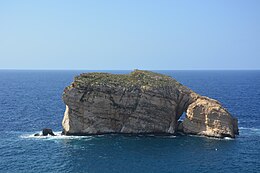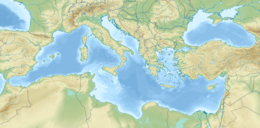Fungus Rock
Native name: Il-Ġebla tal-Ġeneral | |
|---|---|
 | |
| Geography | |
| Location | off Malta, Mediterranean Sea |
| Coordinates | 36°02′45″N 14°11′27″E / 36.04583°N 14.19083°E |
| Archipelago | Maltese islands |
| Area | 0.007[1] km2 (0.0027 sq mi) |
| Coastline | 494 m (1621 ft) |
| Highest elevation | 60 m (200 ft) |
| Administration | |
Malta | |
| Demographics | |
| Population | 0 |
Fungus Rock, sometimes known as Mushroom Rock,[2] and among the Maltese as Il-Ġebla tal-Ġeneral (Template:Lang-en), is a small islet in the form of a 60-metre-high (200 ft) massive lump of limestone at the entrance to an almost circular black lagoon in Dwejra, on the coast of Gozo, itself an island in the Maltese archipelago. It is located at 36°02′45″N 14°11′27″E / 36.04583°N 14.19083°E and falls within the jurisdiction of the town of San Lawrenz.
History
The Knights Hospitaller apparently discovered what is popularly known as the Maltese fungus growing on the rock's flat top. This plant, which is a kind of parasitic flowering plant, not a fungus, has a repulsive smell. Doctors at the time believed that it had medicinal properties. The Knights used it as a styptic dressing for wounds and a cure for dysentery. They so prized it that they often gave gifts of it to distinguished noblemen and visitors to the Maltese islands.
Grand Master Pinto decreed the Rock out of bounds in 1746; trespassers risked a three-year spell as oarsmen in the Knights' galleys. He posted a permanent guard there and even built a precarious cable-car basket from the rock to the mainland, 50 metres (160 ft) away. He also ordered the sides smoothed to remove handholds.[3][4]
Pinto's efforts were perhaps unnecessary. Pharmacologists are studying the medical effects of Fucus coccineus melitensis[5] today.[when?] [6]
Today, Fungus Rock is a nature reserve. However, the shoreline nearby is accessible to bathers and the sea provides perfect snorkeling.
The sunset can be photographed through the opening in Fungus Rock, but only from the inlet anchorage, and only during seasons when the sun descends the right way.
-
Fungus Rock's rear view
-
Cynomorium coccineum, the strange plant that gave Fungus Rock its name
-
Sunset through Fungus Rock
Notes
- ^ State of the Environment Report for Malta 1998 Archived 2015-04-02 at the Wayback Machine
- ^ Ganado, Albert (2005). "Bibliographical notes on Melitensia - 3". Journal of the Malta Historical Society. 14 (2). Melita Historica: 178. Archived from the original on 21 April 2014.
- ^ Dharmananda, Subhuti. "Cynomorium: Parasitic Plant Widely Used in Traditional Medicine". Retrieved 2 November 2010.
- ^ The historical guide to the island of Malta and its dependencies. p. 88.
- ^ Correctly known as Cynomorium coccineum; it is not a Fucus, which is a genus of seaweed.
- ^ Botanical Society of Edinburgh (1870). "Agriculture of Malta and Sicily". Transactions and Proceedings of the Botanical Society of Edinburgh. Botanical Society of Edinburgh. p. 115. Retrieved 2009-01-04.
External links
![]() Media related to Fungus Rock at Wikimedia Commons
Media related to Fungus Rock at Wikimedia Commons





